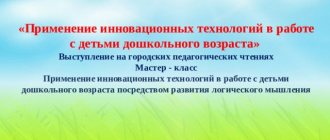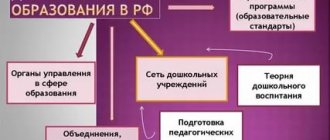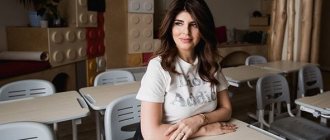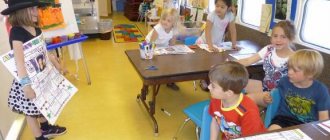Many experts note that those children who did not go to kindergarten and were prepared for school at home do not always fit harmoniously into the group of first-graders. The problem is that parents do not always have all the necessary knowledge and skills to help their beloved child learn to communicate not only with them, but also with the outside world. Therefore, it is important to pay full attention to the child’s development. In addition to physical development, we must not forget about other aspects.
In the modern world, pedagogy and methods of preschool education are closely related. Therefore, parents should be not only true friends of their child, but also his first teachers.
Preschool age
Many people mistakenly avoid this topic, which is why classes with children begin at an untimely time. Therefore, before moving on to the theory and methodology of preschool education, it is worth considering several important stages in the formation of a child’s personality. The first years of life, the baby lives in his own world. He is just beginning to learn about his new surroundings, which cause him genuine amazement and fear. Gradually, the child learns to interact with objects and people around him. He takes the first step and says the cherished “mom” and “dad”.
Experts usually divide the preschool age itself into three stages:
- Jr. In this case, we are talking about the methodology of preschool education, which should be based on the fact that during this period the child begins to identify himself, his “I” is born. The baby learns to evaluate the attitude of others and can easily determine if the parents are happy with him or, conversely, angry. At the same time, it is important to pay attention to activities aimed at developing fine motor skills. Junior preschool age lasts from 3 to 4 years.
- Average. This period lasts from 4 to 5 years. The child begins to form his own concepts and peculiarities of thinking. Gradually, the baby acquires character traits and expresses himself more actively as a person. During this period, the methodology of preschool education should be aimed not only at the development of logic and thinking, but also at the development of more complex motor functions.
- Senior. In this case we are talking about children aged 5 to 7 years. This period is characterized by increased thinking. The child begins to understand that he must perform some duties around the house (for example, putting away toys, helping his mother, etc.). At the same time, he must be able to control his emotional state. By this age, the baby is already quite dexterous, but he must continue to develop physically.
Preschool age
Dr. Suzuki's method
Violinist and teacher Shinichi Suzuki believed that all children are naturally talented, so this should not be ignored. If children are surrounded by pleasant music and classical works, this will help them become wonderful, kind and open people.
How to raise children using this method
Sh. Suzuki believed that if a child begins to talk by being completely immersed in his native speech, then by the same principle one can surround him with music and unleash his creative potential.
Basic provisions of the methodology:
- The baby should listen to music from birth, and from the age of two you can teach him to play musical instruments;
- You can send him to a music school when he begins to show a real craving for art;
- work should take place in groups of 3-4 people, so that everyone has the motivation to follow the others;
- The repertoire is carefully selected for each musical instrument so that skills develop gradually.
Advantages and disadvantages
Advantages:
- the method is based on internal motivation, so the likelihood that learning music will get boring is minimal;
- can be tested on any child, because everyone has talent;
- can be used as a complement to other parenting approaches;
- The baby develops a sense of beauty.
Flaws:
- many areas of development are touched upon only superficially;
- classes do not guarantee that the student will become a virtuoso musician and achieve great success.
Preschool education programs and methods
The general educational process primarily means certain educational actions that are combined with training and preparation for school. Thus, this is a whole complex of activities. Some parents send their children to preschool education institutions, where teachers prepare them for subsequent education.
Thus, the educational methodology of preschool education is fundamental. It consists of four stages. First of all, it is important to pay attention to the formation of the child’s personality. He must learn to form his own judgments and assess the situation. The second stage is organizing the child’s actions. This means that the child must be able to interact with adults and peers. Even before the first trip to school, the child should already have some experience of communication.
In addition, it is important to form the correct self-esteem and motivation in the child. For this purpose, different methods of preschool education and upbringing are used. They can be successfully used at home.
What exactly do teachers use in the educational process and how to choose the right method?
In practice, teachers and educators choose methods for teaching children, guided by the objectives of the educational process, as well as the age and individual characteristics of preschoolers. The choice of a specific technique depends on the upcoming lesson in kindergarten and its ultimate goals.
- Visual techniques
include observation (the skill of peering into the phenomenon of the surrounding world, noticing changes, additions, identifying the cause and drawing the right conclusion) and demonstration (visual representation of both familiar and still unknown objects).
- Practical techniques
involve performing exercises (repeated repetition of mental or practical actions for better assimilation), conducting experiments (research to acquire knowledge) and modeling (map, plan, manual).
- Through gaming techniques
imaginary situations are created (for example, a market game to study types of vegetables), and teachers also invite children to participate in didactic games (for better assimilation of knowledge).
- Verbal techniques
– this is a conversation, story and reading fiction (suitable for studying and remembering information, developing imagination and memory).
Of course, we, adults, must not forget that kindergarten is the child’s first experience in independent life, therefore, in addition to the necessary skills, educational methods should bring the child joy and pleasure from his first achievements.
Promotion
A similar method of teaching, preschool education and upbringing allows you to adjust the child’s behavior. A child who is preparing to go to school must learn to distinguish bad deeds from good ones and correctly place emphasis. He must not behave inappropriately in society. It is important to develop respect for his parents.
Promotion
Thanks to encouragement, the child’s positive thinking is strengthened. If he feels positive by doing something good, then it will help him become a good person. It is worth considering that until the age of six, children really need praise, so this method is very effective. However, it is important not to develop too much of a consumerist attitude in your child.
Therefore, this method of preschool education must be used very carefully. For example, you should not say: “If you brush your teeth today, I will give you a new toy.” It’s better to wait until the baby completes the required action and give him a small present, as if for no reason. His brain will automatically associate pleasant emotions with brushing his teeth.
Methodology of A. S. Makarenko
The educational system of A. S. Makarenko, according to UNESCO, influenced the pedagogical thinking of the 20th century along with the thoughts and ideas of such teachers as D. Dewey, G. Kresshensteiner, M. Montessori.
With his methods, the teacher was able to quickly re-educate street children and hooligans into full-fledged members of society.
How to educate
A. S. Makarenko believed that the work of a teacher should be carried out in accordance with the following principles.
- The role of the educator. A mentor must influence students by personal example. Only his knowledge, kindness and care towards them brings benefits. Pettiness, nagging and callousness will not help you become an authority for children.
- Punishment and reward. Both good and bad deeds should be marked accordingly. A teacher who does not react to negative manifestations of personality in the team cannot resist children's aggression and lead students along.
- Labor education. In this method, work is considered as a necessary part of education. The main thing is that this should not just be mechanical work, but reasonable actions. Children should know what results their actions will lead to and to whom they will be useful. For example, subsistence farming will help feed the entire team.
- Collectivism. It is the team that has the greatest influence on the education of its members. At the same time, it is important that people are not just united with each other on the same territory, but have a common socially significant goal.
- Self management. Everyone should be aware of their place in the team and feel comfortable. Children learn to make decisions themselves, analyze their results and assign roles.
- Discipline. Certain rules in the team force students to control not only themselves, but also those around them. Traditions, rituals and general norms of behavior help unite children among themselves.
- Perspective lines. The development of the team and the individual can only occur if there are further goals and prospects. If a person does not experience joy from approaching the cherished result, then he has no future.
Advantages and disadvantages of the method
The advantages of A. S. Makarenko’s technique include:
- mastering everyday skills and self-government help raise a person who is adapted to life in society;
- rewards and punishments, as well as discipline, help increase the level of responsibility for one’s actions;
- The influence of the team on the individual contributed to the fact that the technique became widely used in corporate culture.
Among the disadvantages are:
- insufficient attention to the individuality and characteristics of each individual child;
- exploitation of child labor, which is prohibited.
Punishment
Modern methods of education in the field of preschool education, as a rule, exclude such methods of interaction with children. However, in some situations there is simply no other way to do it. For example, if the child is hyperactive and cannot be controlled by parents. However, physical punishment should be completely excluded.
It is also important to take into account some features of this approach. First of all, you cannot scold your child for actions that he committed a long time ago. Also, preventive punishment will not lead to anything good. Sometimes, in order to prevent the child from misbehaving, parents begin to punish him for something that he has not yet done at all.
Experts do not recommend using such methods, as parents often resort to humiliation. If they do not punish, but insult the child, then this will negatively affect his psyche.
Punishment
Methodology of Leonid Bereslavsky
L. Ya. Bereslavsky is a professor, physicist, doctor of philosophy and teacher who has written more than two dozen books on preschool education.
With the birth of his second child, he began to seriously think about whether he would have time to invest everything he wanted in his children and raise them to be good people. This is what motivated him to create his own educational method based on the experience of other teachers.
How to raise a baby
L. Ya. Bereslavsky was of the opinion that it is necessary to develop intelligence not only in a timely manner, but also systematically. This will help your child do well in school, make progress in various areas of activity and achieve their goals.
Previous learning is considered in this methodology as the foundation for further knowledge and skills. If the child has not previously encountered such easy tasks, then he will not be able to complete more complex ones. It is important that as many parts of the brain as possible are involved, otherwise the unused ones may remain dormant.
Classes can be held for even the shortest time (3-5 minutes), but they must have a logical conclusion.
Principles of teaching L.Ya. Bereslavsky:
- the activity should be carried out in a playful way;
- all material should be presented in a systematic manner, with repetition and deepening of the material covered;
- the teacher must get used to the role of the actor and the child in order to increase interest in the lessons;
- mental activity should alternate with physical activity;
- Special attention should be paid to the development of independence.
Advantages and disadvantages
Advantages:
- comprehensive personality development;
- emphasis on the development of memory and logical thinking;
- children's development can occur continuously;
- The knowledge invested at a young age will become the basis for learning in the future.
Flaws:
- the emphasis is on logic and other personality inclinations are not taken into account.
Belief
With the development of preschool education methods, specialists are increasingly using precisely these methods of interaction with children. In this case, we are talking about the fact that the parents talk to the baby as to an adult, explaining to him the correct actions and unacceptable ones.
In this case, it is important to take into account the individual characteristics of the child’s behavior. The conversation should be conducted in such a way that the conversation is as logical as possible for the child. There is no need to indulge in complex demagoguery and jump from one topic to another. The child must focus and understand what is required of him.
This is one of the so-called blocks of teaching methods in preschool education. First of all, a child needs to be formed into a personality that will be ready for educational activities. Considerable importance should also be given to mental preparation and motor development. It is worth considering these features in more detail.
Mental education
If parents do not pay enough attention to this aspect, then it will be much more difficult for the child to integrate into the educational process at school. Therefore, it is extremely important that the baby is inquisitive and able to think from a very early age. At the same time, attention is paid to the development of memory, speech and attention.
Mental education
According to teaching methods in the field of preschool education, by the age of six, a child should be able to draw. This means that you need to teach your child to at least repeat certain patterns. If he has a penchant for creativity, then you should not limit him. Children who draw rather than copy have great potential, which is recommended to be developed more.
Also, before going to school, the child must learn to color pictures and be able to at least partially follow the contours. This is important, since in the first years at school he will focus on spelling.
In addition, parents are recommended to teach their child to learn short rhymes. It would be good if he knew what a retelling is. Therefore, you can read short stories to your child and then ask him to describe what he remembers.
By the age of six, children can often count to at least 10. They know where they live, can name the last and first names of their mother and father, and understand the seasons. It is worth teaching the baby months. Some parents, even before going to school, explain how to correctly determine the time on the clock.
It’s easy to see that a lot is required from mom and dad. Parents should teach their child the basics so that in first grade not all information is a discovery of a new world for him. To achieve the best results, it is recommended to study the basics of preschool education methods.
As a rule, mental development involves the use of various educational games. It is worth reading books to your child as much as possible, and not allowing him to spend all his free time in front of the computer or with a mobile phone in his hands.
Technique Jean Ledloff
The famous psychologist Jean Ledloff created her natural parenting method, inspired by the relationships between children and parents in the Yaquana Indian tribe. She noticed that in their families there is no corporal punishment or screaming from parents, and children, in turn, do not manipulate crying and help adults on their own initiative. She described all her observations in detail in the book “How to Raise a Happy Child.”
How to educate
The principle on which the entire methodology is based is simple: the mother initially contains everything that is required for the proper upbringing of children. The main thing is to listen to your feelings and the needs of the child.
In order for the baby to feel loved and not deprived of attention, the mother should spend as much time as possible next to him (especially in infancy).
You can talk about relationships with children in several theses:
- until the child has learned to crawl, it is important to give him the opportunity to spend as much time as needed in his mother’s arms;
- the more the baby takes part in the daily affairs of his parents, the easier his socialization process is;
- feeding on demand;
- guardianship only interferes with the child’s development; he should have the opportunity to learn new things and explore the world around him;
- evaluate only the actions of children, and not their personality;
- Mom should be a friend and helper who will always be there.
Advantages and disadvantages
The advantages of J. Lidloff’s technique are:
- the closeness of mother and baby from the first days of his life helps to form his basic trust in the world, laying the foundation for raising a happy and healthy person;
- the absence of movement restrictions, such as playpens, helps children avoid problems with speech and better feel their body and navigate in space;
- Understanding by parents that they are raising their children correctly contributes to harmony in family relationships.
Disadvantages include the fact that not all Indian principles and advice can be followed and applied in the modern world.
Physical education
Do not forget that at school the child will be engaged in more than just mental activities. You need to understand that the first 6-7 years of a child’s life are characterized by increased activity and mobility. During this period, it is very important to direct it in the right direction. As a rule, this responsibility falls on the parents. Or you can send your child to a sports section for the little ones, where a specialist will take on this mission.
If we talk about working independently with a child, then in this case it is worth paying attention to several important stages. First of all, the child must understand what recovery is. Experts recommend practicing hardening procedures, preventing flat feet, etc.
Physical education
By the age of 6, it is worth teaching your child to swim, run, jump and the simplest games on the playground. This will help build his endurance, agility and speed of reaction. Since children at this age are quite active themselves, it will not be difficult to involve them in such activities. For example, parents can start doing sports or recreational treatments in the fresh air with their child. This will also help strengthen the family bond.
It would be a good idea to buy sports equipment. If a child has a horizontal bar, a jump rope and a ball in his room, he will be able to practice independently, without the participation of adults. However, the area of a children's room does not always allow you to place everything you need there. In this case, you can enroll your child in the sports section.
Physical education helps to discipline a child. He gets used to the daily routine and begins to understand what a healthy lifestyle is. At the same time, strong-willed qualities are developed. The child begins to understand that not everything comes so easily. In order to achieve this goal, it is necessary to make considerable efforts. All this also has a positive impact on the formation of the future student’s personality.
It is also worth considering that today there may be outdated methods of preschool education. Retraining of specialists has become very important, since what worked 50 years ago is not so effective in the age of computer technology. Therefore, it is worth considering several techniques that are successfully used today.
Maria Montessori system
This program is designed for preschoolers from 3 years old, but modern experts say that it is acceptable at an earlier age. The main principle of the system is based on the fact that the child is given complete freedom. The child is free to choose what interests him and spend his free time as he wishes.
Maria Montessori system
But this does not mean permissiveness. The point is that the child only thinks that he is not forced, but he does something himself. This means that parents are required to subtly push him into one activity or another. In this case, he will not have the impression that something is being imposed on him.
Zaitsev cubes
This technique is aimed at teaching reading and writing. Thanks to this, children show their first successful results already at the age of 2-3 years. The system is extremely simple. Parents purchase 52 cubes, each of which has letters, numbers, etc. written on it. Thanks to this, the baby begins to form words very quickly and imperceptibly. If you additionally hang warehouses on the wall, the child will repeat what he sees. In addition, this has a positive effect on the development of hand motor skills. If you regularly practice with cubes, the results will not take long to arrive.
Thus, parents can independently prepare their child for school. If mom and dad devote enough time to raising the baby, then he will sit at the school desk already prepared. If both parents work, it is recommended to consider the possibility of classes with specialists. In preschool institutions, children receive all the necessary basic knowledge. At the same time, the child will communicate with peers and learn to establish friendships.






